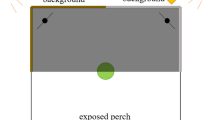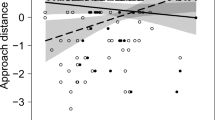Abstract
Nest and territory defence are risky and potentially dangerous behaviours. If the resolution of life history trade-offs differs between individuals, the level of defence may also vary among individuals. Because melanin-based colour traits can be associated with life history strategies, differently coloured individuals may display different nest and territory defence strategies. We investigated this issue in the colour polymorphic tawny owl (Strix aluco) for which plumage varies from dark to light reddish melanic. Accordingly, we found that (1) our presence induced a greater response (flying around) from dark-coloured than light-coloured females and (2) dark reddish males suffered lower nest predation rates than light-coloured males. In experimentally enlarged broods, the probability that females reacted after we played back the hoot calls of a stranger male was higher if these females were lighter reddish; the opposite pattern was found in experimentally reduced broods with dark parents being more reactive than light parents. Finally, darker females alarmed more frequently when paired with a light than with a dark male, suggesting that partners adjust their behaviour to each other. We also tested whether colouration is used as a signal by conspecifics to adjust the level of their defensive behaviour. Accordingly, breeding females responded more vigorously to a dark than a light reddish stuffed tawny owl placed beside their nest. We conclude that melanin-based colouration is a signal of alternative nest and territory defence behaviour that depends on ecological factors.






Similar content being viewed by others
References
Appleby BM, Yamaguchi N, Johnson PJ, MacDonald DW (1999) Sex-specific territorial responses in tawny owls Strix aluco. IBIS 141:91–99
Baker K (1993) Identification guide to European non-passerines. British Trust for Ornithology Guide 24. British Trust for Ornithology, Norfolk
Baudvin H, Dessolin L (1992) Analyse de la morphometrie de la chouette hulotte (Strix aluco) en Bourgogne. Alauda 60:3–104
Birrer S, Hüsler M (2003) Ein Fall von Infantizid bei der Schleiereule Tyto alba. Ornithol Beob 100:143–146
Boerner M, Kruger O (2009) Aggression and fitness differences between plumage morphs in the common buzzard (Buteo buteo). Behav Ecol 20:180–185
Brommer JE, Ahola K, Karstinen T (2005) The colour of fitness: plumage coloration and lifetime reproductive success in the tawny owl. Proc R Soc Lond B 272:935–940
Buchanan KL, Evans MR, Goldsmith AR (2003) Testosterone, dominance signalling and immunosuppression in the house sparrow, Passer domesticus. Behav Ecol Sociobiol 55:50–59
Ducrest AL, Keller L, Roulin A (2008) Pleiotropy in the melanocortin system, coloration and behavioral syndromes. Trends Ecol Evol 23:502–510
Fontaine JJ, Arriero E, Schwabl H, Martin TE (2011) Predation and circulating corticosterone levels within and among species. Condor 113:825–833
Galeotti P (1990) Territorial behaviour and habitat selection in an urban population of the tawny owl Strix aluco L. Bull Zool 57:59–66
Galeotti P, Pavan G (1991) Individual recognition of male tawny owls (Strix aluco) using spectrograms of their territorial calls. Ethol Ecol Evol 3:113–126
Galeotti P, Pavan G (1993) Differential responses of territorial tawny owls Strix aluco to the hooting of neighbours and strangers. IBIS 135:300–304
Galeotti P (2001) Strix aluco tawny owl. BWP Update 3:43–77
Galeotti P, Sacchi R (2003) Differential parasitaemia in the tawny owl (Strix aluco): effects of colour morph and habitat. J Zool 261:91–99
Gasparini J, Bize P, Piault R, Wakamatsu K, Blount JD, Ducrest AL, Roulin A (2009) Strength and cost of an induced immune response are associated with a heritable melanin-based colour trait in female tawny owls. J Anim Ecol 78:608–616
Glutz von Blotzheim UN (1987) Handbuch der Vögel Mitteleuropas. Aula-Verlag, Wiesbaden
Hogstad O (1995) Alarm calling by willow tits, Parus montanus, as mate investment. Anim Behav 49:221–225
Karell P, Ahola K, Karstinen T, Kolunen H, Siitari H, Brommer JE (2011a) Blood parasites mediate morph-specific maintenance costs in a colour polymorphic wild bird. J Evol Biol 24:1783–1792
Karell P, Ahola K, Karstinen T, Valkama J, Brommer JE (2011b) Climate change drives microevolution in a wild bird. Nat Commmun 2:208
Klvanova A, Horakova D, Exnerova A (2011) Nest defence intensity in house sparrows Passer domesticus in relation to parental quality and brood value. Acta Ornithol 46:47–54
Leifert D, Haefliger IO, Pruente C (2004) Imitation of typical birdcall causes ocular perforation by a tawny owl attack. Arch Ophthalmol-Chic 122:1556–1557
Lessels CM, Boag PT (1987) Unrepeatable repeatabilities: a common mistake. Auk 104:116–121
Marler CA, Moore MC (1988) Evolutionary costs of aggression revealed by testosterone manipulations in free-living male lizards. Behav Ecol Sociobiol 23:21–26
Maynard Smith J, Parker GA (1976) The logic of asymmetric contests. Anim Behav 24:159–175
Mettke-Hofmann C (2012) Head colour and age relate to personality traits in Gouldian finches. Ethology 118:906–916
Møller AP (1987) Variation in badge size in male house sparrows Passer domesticus—evidence for status signaling. Anim Behav 35:1637–1644
Montgomerie RD, Weatherhead PJ (1988) Risks and rewards of nest defence by parent birds. Q Rev Biol 63:167–187
Piault R, Gasparini J, Bize P, Jenni-Eiermann S, Roulin A (2009) Pheomelanin-based coloration and the ability to cope with variation in food supply and parasitism. Am Nat 174:548–556
Pryke SR, Griffith SC (2009) Socially mediated trade-offs between aggression and parental effort in competing color morphs. Am Nat 174:455–464
Quesada J, Senar JC (2007) The role of melanin- and carotenoid-based plumage coloration in nest defence in the Great Tit. Ethology 113:640–647
Redpath SM (1994) Censusing tawny owls Strix aluco by the use of imitation calls. Bird Study 41:192–198
Roff DA (1992) The evolution of life-histories—theory and analysis. Chapmann and Hall, New York
Roulin A (2004) The evolution, maintenance and adaptive function of genetic colour polymorphism in birds. Biol Rev 79:815–848
Roulin A, Bize P, Ravussin P, Broch L (2004) Genetic and environmental effects on the covariation between colour polymorphism and a life-history trait. Evol Ecol Res 6:1253–1260
Roulin A, Ducret B, Ravussin P, Altwegg R (2003) Female colour polymorphism covaries with reproductive strategies in the tawny owl Strix aluco. J Avian Biol 34:393–401
Roulin A, Emaresi G, Bize P, Gasparini J, Piault R, Ducrest AL (2011) Pale and dark reddish melanic tawny owls differentially regulate the level of blood circulating POMC prohormone in relation to environmental conditions. Oecologia 166:913–921
Roulin A, Gasparini J, Bize P, Ritschard M, Richner H (2008) Melanin-based colorations signal strategies to cope with poor and rich environments. Behav Ecol Sociobiol 62:507–519
SAS (2008) SAS 9.1, 91st edn. SAS, Carey
SAS (2010) JMP 9.02, 902nd edn. SAS, Carey
Sasvari L, Peczely P, Hegyi Z (2009) Plasma testosterone profile of male tawny owls Strix aluco in relation to breeding density, breeding experience, and offspring provision. Acta Ornithol 44:59–68
Senar JC, Camerino M (1998) Status signalling and the ability to recognize dominants: an experiment with siskins (Carduelis spinus). Proc R Soc Lond B 265:1515–1520
Stearns SC (1989) Trade-offs in life-history evolution. Funct Ecol 3:259–268
Stearns SC (1992) The evolution of life histories. Oxford University Press, Oxford
Sternalski A, Bretagnolle V (2010) Experimental evidence of specialised phenotypic roles in a mobbing raptor. Behav Ecol Sociobiol 64:1351–1361
Sunde P (2008) Parent–offspring conflict over duration of parental care and its consequences in tawny owls Strix aluco. J Avian Biol 39:242–246
Sunde P, Bølstad MS (2004) A telemetry study of the social organization of a tawny owl (Strix aluco) population. J Zool 263:65–76
Tuttle EM (2003) Alternative reproductive strategies in the white-throated sparrow: behavioral and genetic evidence. Behav Ecol 14:425–432
van den Brink V, Dolivo V, Falourd X, Dreiss AN, Roulin A (2012a) Melanic color-dependent antipredator behavior strategies in barn owl nestlings. Behav Ecol 23:473–480
van den Brink V, Henry I, Roulin A (2012b) Docility covaries with a eumelanin plumage trait in juvenile kestrels (Falco tinnunculus). Ethology 18:673–682
Wallin K (1987) Defense as parental care in tawny owls (Strix aluco). Behaviour 102:213–230
Webster A, Cooke R, Jameson G, Wallis R (1999) Diet, roosts and breeding of powerful owls Ninox strenua in a disturbed, urban environment: a case for cannibalism? Or a case of infanticide? EMU 99:80–83
Wiklund CG, Stigh J (1983) Nest defense and evolution of reversed sexual size dimorphism in snowy owls Nyctea scandiaca. Ornis Scand 14:58–62
Williams GC (1966) Natural selection costs of reproduction and a refinement of Lack’s principle. Am Nat 100:687–690
Wolf M, Van Doorn GS, Leimar O, Weissing FJ (2007) Life-history trade-offs favour the evolution of animal personalities. Nature 447:581–584
Acknowledgments
We thank Wolf Harmening for his advice and Rory Hambling (UK) for providing us with the sample of the hooting male owl. The study was financed by the Swiss National Science Foundation to AR (grant no. 31003A_120517). We are grateful to the three reviewers who provided useful comments on an earlier version of the text.
Ethical standards
The study was carried out with the authorization of the ‘Service Vétérinaire du canton de Vaud’.
Author information
Authors and Affiliations
Corresponding author
Additional information
Communicated by K. McGraw
Arnaud Da Silva and Valentijn van den Brink contributed equally to this work.
Rights and permissions
About this article
Cite this article
Da Silva, A., van den Brink, V., Emaresi, G. et al. Melanin-based colour polymorphism signals aggressive personality in nest and territory defence in the tawny owl (Strix aluco). Behav Ecol Sociobiol 67, 1041–1052 (2013). https://doi.org/10.1007/s00265-013-1529-2
Received:
Revised:
Accepted:
Published:
Issue Date:
DOI: https://doi.org/10.1007/s00265-013-1529-2




